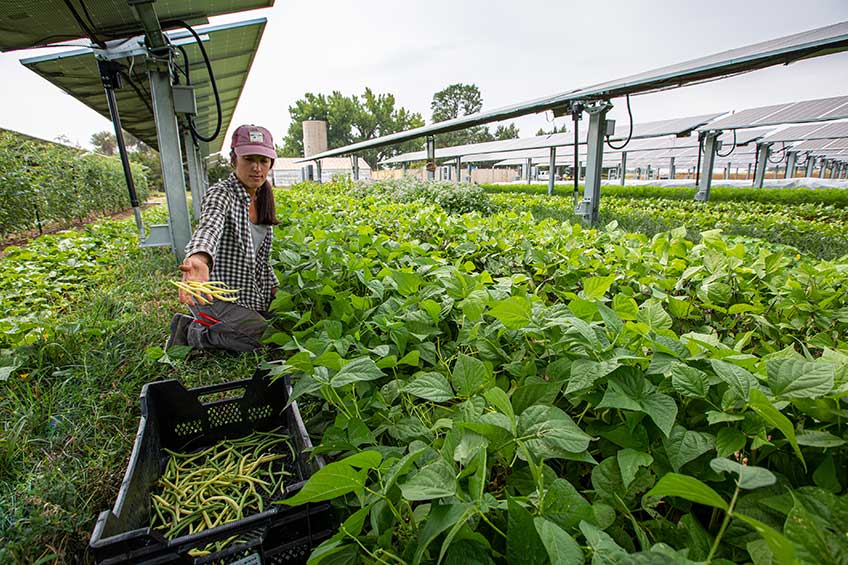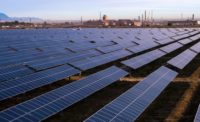The Delta County, Colo., Board of Commissioners unanimously approved on Aug. 17 a large-scale solar project on the state's Western Slope after rejecting it just five months earlier.
When complete, the 80-MW Garnet Mesa Solar Project on 383 acres on a former ranch southeast of Delta will be the largest solar farm on the Western Slope of the Rocky Mountains west of the Continental Divide, and the largest “agrivoltaic” installation in Colorado.
Agrivoltaics—solar projects on actively used farm or grazing land—represent a possible dual use for the estimated 900 million agricultural acres in the U.S. A 2019 Oregon State University study found that installing solar panels on a mere 1% of U.S. farmland could fulfill global energy demand.
The owner of Garnet Mesa Solar, Denver-based Guzman Energy, increased the number of sheep grazing to 1,000 head to win approval, and the site could also include an apiary to support bees.
The $80-million project will create 350 to 400 jobs during construction, to be overseen by subcontractor Citra Power. It will generate about 200,000 MW-hours of electricity annually, enough to power 18,000 homes.
Maximizing Land Potential
Maintaining the rural character and agriculture use of the site was critical to the board’s decision. The sheep, part of a local livestock operation, are difference makers. “With sheep grazing, [the solar panels] don’t have to be extremely high, and of course use the shade and are able to graze,” explains Les Owen, director of the Conservation Services Division at the Colorado Dept. of Agriculture. “The solar developer doesn’t have to manage the vegetation, the sheep do it, so it’s kind of a win-win there.”
Agrivoltaics have potential on cropland as well, but installations cannot obstruct tractors and sunlight. “People are still playing with different types of crops that benefit from partial shade,” says Owen, citing Jack’s Solar Garden near Longmont, Colo., as a regional leader. “With the renewable goals the state and the nation has set, the amount of these multiple uses for land are definitely going to expand. It’s just maximizing the potential of the land.”
Jordan Macknick, a researcher at the National Renewable Energy Laboratory in Golden, Colo., leads InSPIRE (Innovative Solar Practices Integrated with Rural Economies and Ecosystems). The project tracks about 300 agrivoltaic sites in the U.S., but Macknick estimates a national total of about 500 that can generate nearly 3 gigawatts annually, with higher concentrations in the Northeast, Southeast and Midwest.
Pollinator habitat and sheep grazing are the top two agricultural uses. “For both pollinator habitat as well as grazing, solar developers don’t have to do a lot of changes to the infrastructure or the design of the system,” Macknick says. “Your standard utility-scale design should work fine.”
Other uses require more expensive designs, so only about 30 agrivoltaic sites nationwide involve crop production. “That’s where you start seeing more of an incentive to change the design of the system,” Macknick says. “That could be elevating panels, that could be spreading panels apart, that could be having spaces in between panels.”
There are roughly 30 million cows in the U.S.—versus only 5 million sheep—so there’s much more room for agrivoltaic projects on cattle pastures. But there's a catch. “If you wanted to graze cattle under a solar array, cow-proofing solar panels is a heck of a lot more expensive than sheep-proofing,” says Owen. “You’d have to make them a lot taller plus you’d have to make them a heck of a lot stouter, because cows like to rub up against stuff. They can be a bit destructive.”
NREL is partnering with Silicon Ranch Corporation, a Tennessee-based solar developer, to evaluate agrivoltaics on cattle ranches. Macknick highlights a benefit at test sites: “In the projects that we’ve seen, the cattle love the shade. They love being under the panels. It’s great for them. If we could figure out a way to do it and scale it up, that would be a game changer.”
Water Reduction
While the West currently lags on InSPIRE’s agrivoltaic map, Macknick says he sees plenty of potential. “We have an abundance of sunlight, but we’re limited on water. Agrivoltaics partially reduce the amount of sunlight and heat you’re having on the ground, which also in turn helps save water.”
Case in point: A tomato-growing test site in Arizona doubled the yields under the solar panels while using 30% less water. “That’s a really great outcome I think we can replicate in other parts of the West,” says Macknick, noting that agrivoltaics are compatible with tomatoes as well as peppers and leafy greens. “We’re looking at melons, we’re looking at beans, we’re looking at over 15 crop types right now.”
He adds, “One of my favorite ways I’ve heard it described is harvesting the sun twice. You’re producing electricity, and all the sun that goes around and underneath the panels, you are able to make use of as well in that agricultural context. I think we’re going to see a lot more large-scale utility projects.”




Post a comment to this article
Report Abusive Comment